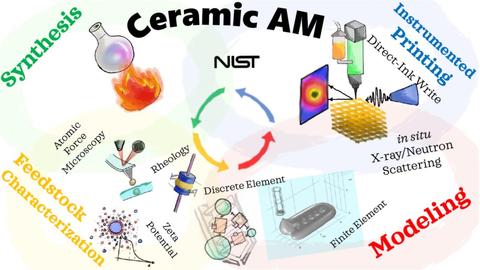Summary
The NIST program seeks to facilitate the commercialization of the ceramics additive manufacturing via the concurrent development of:
- New measurement approaches to characterize AM processes relevant to ceramic materials
- Computational methods for predictive modeling of an AM workflow, from feedstock to a printed part
The experimental and modeling parts are envisioned to be interdependent, with the former used to guide and validate computer models and develop standards and databases (in collaboration with stakeholders).
A distinct feature of ceramics AM is that it commonly yields non-dense, porous parts, which are then densified in a sintering step, a complex and costly process. Therefore, another part of the NIST program is developing measurements to characterize novel cost-effective post-processing methods that can be integrated with an AM build process.
Description

Additive manufacturing (AM) is a rapidly growing suite of technologies that has been a national priority since 2012. Compared to metals and polymers AM, the commercial adaptation of ceramics AM is still in its infancy. Nevertheless, ceramics AM is actively explored for applications in aerospace, energy, defense, health, and electronic sectors. Its market size is projected to increase tenfold in the next five years. Technical barriers for broader commercialization include: (1) improvements in the performance of AM-built ceramic parts, which often remains inferior to that achieved using traditional manufacturing, 2) cost, and 3) certification hurdles. From the metrology standpoint, there is urgent need for testing methods and standards adapted to ceramic feedstock and AM-built parts and for databases of feedstock characteristics, AM process parameters, and properties of the resulting product. Additionally, the field suffers from the deficit of validated computer modeling approaches required to guide ceramics-AM development and optimization.
Current Focus (FY21-FY23)
Development of computational approaches and software tools to enable predictive simulations of a complete AM workflow
Goal 1: Develop modeling of extrusion & deposition DIW processes for ceramic suspensions/pastes using combined discrete-element (DEM) and continuum computational fluid dynamics (CFD) methods. Microscopic DEM provides insights into the behavior of suspensions at the individual-particle level but is prohibitively slow for larger-scale problems where a continuum CDF treatment has clear advantages. Our plan is to combine these approaches to balance accuracy and scalability. The modeling will cover the entire AM-build workflow, reproducing the behavior of a ceramic suspension as it passes through a nozzle and is deposited to form a printed part. Two case systems will be considered during this period: ZnO, a common electronic ceramic also amenable to post-processing via cold sintering, and ZrO2, a mainstream ceramic with both structural and electronic applications.
Development of experimental AM infrastructure for guiding and validating computational modeling methods
Goal 2: Develop DIW instrumentation and process diagnostics, including capabilities for feedstock synthesis and characterization. AM modeling requires an input of typical feedstock characteristics, such as particle sizes and morphologies, interparticle forces, rheological properties, and the knowledge of DIW parameters (geometry, printing speed, layer height, etc.). A recent ASTM survey confirmed standardized feedstock characterization to be of major interest to the community. Concurrently, validation of the modeling methods involves comparing predicted and experimental printed-part characteristics (microstructural and density uniformity, surface roughness, defects, texture, etc.).
In situ characterization of AM processing and post-processing
Goal 3: Develop capabilities for in situ characterization of ceramic DIW and post-build sintering using X-ray and neutron scattering. Real-time rheological studies of concentrated colloidal suspensions while subjected to oscillatory shear, coupled with in situ characterization of the evolution of particle morphologies using X-ray and neutron small angle scattering, can provide major insights into the physics and chemistry of the suspension, allowing various rheological properties to be optimized directly. In situ studies of ceramic suspensions/pastes during printing will provide input for the modeling and facilitate model validation.
Postdoctoral Opportunities
Ceramic Additive/Advanced Manufacturing
http://nrc58.nas.edu/RAPLab10/Opportunity/Opportunity.aspx?LabCode=50&ROPCD=506521&RONum=C0562
Modeling and Simulation in Ceramic Additive Manufacturing
http://nrc58.nas.edu/RAPLab10/Opportunity/Opportunity.aspx?LabCode=50&ROPCD=506431&RONum=C0579
Other Publications
In situ characterization of ceramic cold sintering by small-angle scattering (2021)
https://doi.org/10.1111/jace.17664
Materials research & measurement needs for ceramics additive manufacturing (2020)
https://doi.org/10.1111/jace.17369

